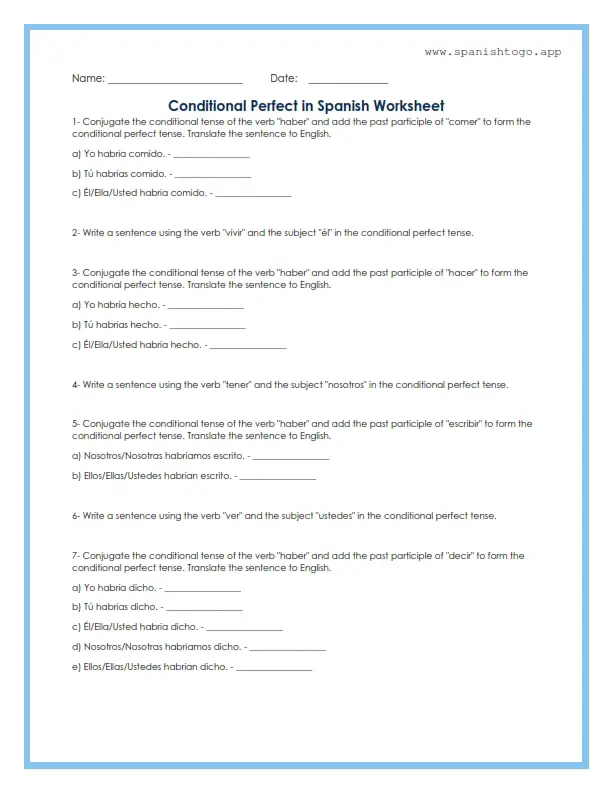Category: Spanish Worksheet
-

-
Months of the Year in Spanish Worksheet
Months of the Year in Spanish Worksheet Introduction Learning the months of the year in Spanish is a foundational step in language acquisition. This worksheet aims to help you practice and memorize the names of the months in Spanish, enabling you to navigate Spanish-speaking contexts and engage in meaningful conversations. Instructions Below, you will find…
-
Greetings in Spanish Worksheet
Greetings in Spanish Worksheet Introduction Greetings are an essential part of language and culture. Learning how to greet someone in Spanish is a fundamental step in language acquisition. This worksheet aims to help you practice various greetings in Spanish, allowing you to engage in meaningful interactions with Spanish speakers. Instructions Below, you will find English…
-
Gender of Nouns in Spanish Worksheet
Gender of Nouns in Spanish Worksheet Introduction In Spanish, nouns have a gender, either masculine or feminine. Understanding the gender of nouns is crucial for proper grammar and communication. This worksheet aims to help you practice identifying the gender of nouns in Spanish, allowing you to use them correctly in sentences. Instructions Below, you will…
-
Classroom Objects in Spanish Worksheet
Classroom Objects in Spanish Worksheet Introduction Learning the names of classroom objects in Spanish is essential for effective communication and comprehension in a Spanish-speaking learning environment. This worksheet aims to help you practice and memorize the names of common classroom objects in Spanish, enabling you to navigate a Spanish classroom with ease. Instructions Below, you…
-
Family Members in Spanish Worksheet
Here is a family members worksheet to help you learn Spanish: Instructions: Fill in the blank with the correct Spanish word for each family member. Answers: Note: In Spanish, family members are usually preceded by the definite article “el” or “la” (depending on the gender of the family member) to indicate possession or relation. For…
-
Agreement of Adjectives Spanish Worksheet Answers
Here is an agreement of adjectives worksheet to help you learn Spanish: Instructions: Choose the correct form of the adjective to match the gender and number of the noun in each sentence. Answers: Note: In Spanish, adjectives must agree in gender and number with the noun they describe. If the noun is masculine, the adjective…
-
Question Words in Spanish Worksheet
Here is a question words worksheet to help you learn Spanish: Instructions: Fill in the blank with the appropriate question word. Answers: Note: In Spanish, the question words are “qué” (what), “cuál” (which), “dónde” (where), “cuándo” (when), “por qué” (why), “cómo” (how), “quién” (who), and “cuánto/cuánta/cuántos/cuántas” (how much/many). These words are used to form questions…
-
Reflexive Verb Spanish Worksheet
Here is a reflexive verb worksheet to help you learn Spanish: Instructions: Complete each sentence with the appropriate reflexive pronoun and conjugated verb. Answers: Note: In Spanish, reflexive verbs are used when the subject of the verb is also the object of the verb. Reflexive pronouns such as “me” (myself), “te” (yourself), “se” (himself/herself/itself), “nos”…
-
Subject Pronouns Spanish Worksheet Answers
Here is a subject pronouns worksheet to help you learn Spanish: Instructions: Write the correct subject pronoun for each sentence. Answers: Note: In Spanish, the subject pronouns are “yo” (I), “tú” (you, informal), “él” (he), “ella” (she), “usted” (you, formal), “nosotros/nosotras” (we), and “ellos/ellas/ustedes” (they/you all). The subject pronoun usually goes before the verb in…
-
Indirect Object Pronouns Spanish Worksheet
Here is an indirect object pronouns worksheet to help you learn Spanish: Instructions: Replace the indirect object with the appropriate pronoun in the following sentences. Answers: Note: In Spanish, the indirect object pronouns are “me” (to/for me), “te” (to/for you), “le” (to/for him/her/usted), “nos” (to/for us), and “les” (to/for them/ustedes). The indirect object pronoun always…